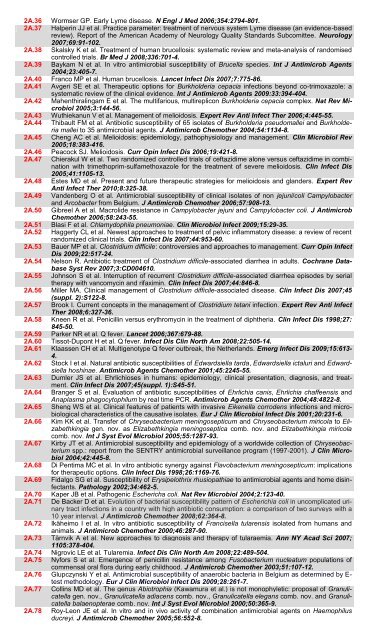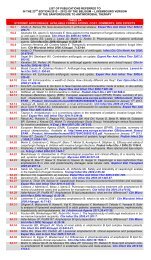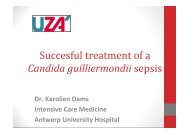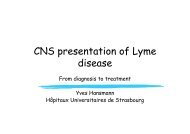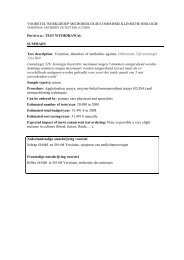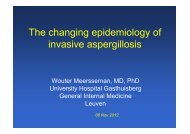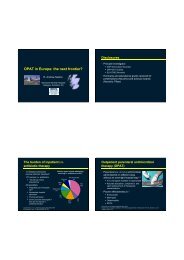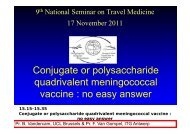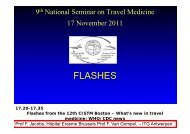TABLE 39A LIST OF PUBLICATIONS REFERRED TO IN THE ...
TABLE 39A LIST OF PUBLICATIONS REFERRED TO IN THE ...
TABLE 39A LIST OF PUBLICATIONS REFERRED TO IN THE ...
You also want an ePaper? Increase the reach of your titles
YUMPU automatically turns print PDFs into web optimized ePapers that Google loves.
2A.36 Wormser GP. Early Lyme disease. N Engl J Med 2006;354:2794-801.<br />
2A.37 Halperin JJ et al. Practice parameter: treatment of nervous system Lyme disease (an evidence-based<br />
review). Report of the American Academy of Neurology Quality Standards Subcomittee. Neurology<br />
2007;69:91-102.<br />
2A.38 Skalsky K et al. Treatment of human brucellosis: systematic review and meta-analysis of randomised<br />
controlled trials. Br Med J 2008;336:701-4.<br />
2A.39 Baykam N et al. In vitro antimicrobial susceptibility of Brucella species. Int J Antimicrob Agents<br />
2004;23:405-7.<br />
2A.40 Franco MP et al. Human brucellosis. Lancet Infect Dis 2007;7:775-86.<br />
2A.41 Avgeri SE et al. Therapeutic options for Burkholderia cepacia infections beyond co-trimoxazole: a<br />
systematic review of the clinical evidence. Int J Antimicrob Agents 2009:33:394-404.<br />
2A.42 Mahenthiralingam E et al. The multifarious, multireplicon Burkholderia cepacia complex. Nat Rev Microbiol<br />
2005;3:144-56.<br />
2A.43 Wuthiekanun V et al. Management of melioidosis. Expert Rev Anti Infect Ther 2006;4:445-55.<br />
2A.44 Thibault FM et al. Antibiotic susceptibility of 65 isolates of Burkholderia pseudomallei and Burkholderia<br />
mallei to 35 antimicrobial agents. J Antimicrob Chemother 2004;54:1134-8.<br />
2A.45 Cheng AC et al. Melioidosis: epidemiology, pathophysiology and management. Clin Microbiol Rev<br />
2005;18:383-416.<br />
2A.46 Peacock SJ. Melioidosis. Curr Opin Infect Dis 2006;19:421-8.<br />
2A.47 Chierakul W et al. Two randomized controlled trials of ceftazidime alone versus ceftazidime in combination<br />
with trimethoprim-sulfamethoxazole for the treatment of severe melioidosis. Clin Infect Dis<br />
2005;41:1105-13.<br />
2A.48 Estes MD et al. Present and future therapeutic strategies for melioidosis and glanders. Expert Rev<br />
Anti Infect Ther 2010;8:325-38.<br />
2A.49 Vandenberg O et al. Antimicrobial susceptibility of clinical isolates of non jejuni/coli Campylobacter<br />
and Arcobacter from Belgium. J Antimicrob Chemother 2006;57:908-13.<br />
2A.50 Gibreel A et al. Macrolide resistance in Campylobacter jejuni and Campylobacter coli. J Antimicrob<br />
Chemother 2006;58:243-55.<br />
2A.51 Blasi F et al. Chlamydophila pneumoniae. Clin Microbiol Infect 2009;15:29-35.<br />
2A.52 Haggerty CL et al. Newest approaches to treatment of pelvic inflammatory disease: a review of recent<br />
randomized clinical trials. Clin Infect Dis 2007;44:953-60.<br />
2A.53 Bauer MP et al. Clostridium difficile: controversies and approaches to management. Curr Opin Infect<br />
Dis 2009;22:517-24.<br />
2A.54 Nelson R. Antibiotic treatment of Clostridium difficile-associated diarrhea in adults. Cochrane Database<br />
Syst Rev 2007;3:CD004610.<br />
2A.55 Johnson S et al. Interruption of recurrent Clostridium difficile-associated diarrhea episodes by serial<br />
therapy with vancomycin and rifaximin. Clin Infect Dis 2007;44:846-8.<br />
2A.56 Miller MA. Clinical management of Clostridium difficile-associated disease. Clin Infect Dis 2007;45<br />
(suppl. 2):S122-8.<br />
2A.57 Brook I. Current concepts in the management of Clostridium tetani infection. Expert Rev Anti Infect<br />
Ther 2008;6:327-36.<br />
2A.58 Kneen R et al. Penicillin versus erythromycin in the treatment of diphtheria. Clin Infect Dis 1998;27:<br />
845-50.<br />
2A.59 Parker NR et al. Q fever. Lancet 2006;367:679-88.<br />
2A.60 Tissot-Dupont H et al. Q fever. Infect Dis Clin North Am 2008;22:505-14.<br />
2A.61 Klaassen CH et al. Multigenotype Q fever outbreak, the Netherlands. Emerg Infect Dis 2009;15:613-<br />
4.<br />
2A.62 Stock I et al. Natural antibiotic susceptibilities of Edwardsiella tarda, Edwardsiella ictaluri and Edwardsiella<br />
hoshinae. Antimicrob Agents Chemother 2001;45:2245-55.<br />
2A.63 Dumler JS et al. Ehrlichioses in humans: epidemiology, clinical presentation, diagnosis, and treatment.<br />
Clin Infect Dis 2007;45(suppl. 1):S45-51.<br />
2A.64 Branger S et al. Evaluation of antibiotic susceptibilities of Ehrlichia canis, Ehrlichia chaffeensis and<br />
Anaplasma phagocytophilum by real time PCR. Antimicrob Agents Chemother 2004;48:4822-8.<br />
2A.65 Sheng WS et al. Clinical features of patients with invasive Eikenella corrodens infections and microbiological<br />
characteristics of the causative isolates. Eur J Clin Microbiol Infect Dis 2001;20:231-6.<br />
2A.66 Kim KK et al. Transfer of Chryseobacterium meningosepticum and Chryseobacterium miricola to Elizabethkingia<br />
gen. nov. as Elizabethkingia meningoseptica comb. nov. and Elizabethkingia miricola<br />
comb. nov. Int J Syst Evol Microbiol 2005;55:1287-93.<br />
2A.67 Kirby JT et al. Antimicrobial susceptibility and epidemiology of a worldwide collection of Chryseobacterium<br />
spp.: report from the SENTRY antimicrobial surveillance program (1997-2001). J Clin Microbiol<br />
2004;42:445-8.<br />
2A.68 Di Pentima MC et al. In vitro antibiotic synergy against Flavobacterium meningosepticum: implications<br />
for therapeutic options. Clin Infect Dis 1998;26:1169-76.<br />
2A.69 Fidalgo SG et al. Susceptibility of Erysipelothrix rhusiopathiae to antimicrobial agents and home disinfectants.<br />
Pathology 2002;34:462-5.<br />
2A.70 Kaper JB et al. Pathogenic Eschericha coli. Nat Rev Microbiol 2004;2:123-40.<br />
2A.71 De Backer D et al. Evolution of bacterial susceptibility pattern of Escherichia coli in uncomplicated urinary<br />
tract infections in a country with high antibiotic consumption: a comparison of two surveys with a<br />
10 year interval. J Antimicrob Chemother 2008;62:364-8.<br />
2A.72 Ikäheimo I et al. In vitro antibiotic susceptibility of Francisella tularensis isolated from humans and<br />
animals. J Antimicrob Chemother 2000;46:287-90.<br />
2A.73 Tärnvik A et al. New approaches to diagnosis and therapy of tularaemia. Ann NY Acad Sci 2007;<br />
1105:378-404.<br />
2A.74 Nigrovic LE et al. Tularemia. Infect Dis Clin North Am 2008;22:489-504.<br />
2A.75 Nyfors S et al. Emergence of penicillin resistance among Fusobacterium nucleatum populations of<br />
commensal oral flora during early childhood. J Antimicrob Chemother 2003;51:107-12.<br />
2A.76 Glupczynski Y et al. Antimicrobial susceptibility of anaerobic bacteria in Belgium as determined by Etest<br />
methodology. Eur J Clin Microbiol Infect Dis 2009;28:261-7.<br />
2A.77 Collins MD et al. The genus Abiotrophia (Kawamura et al.) is not monophyletic: proposal of Granulicatella<br />
gen. nov., Granulicatella adiacens comb. nov., Granulicatella elegans comb. nov. and Granulicatella<br />
balaenopterae comb. nov. Int J Syst Evol Microbiol 2000;50:365-9.<br />
2A.78 Roy-Leon JE et al. In vitro and in vivo activity of combination antimicrobial agents on Haemophilus<br />
ducreyi. J Antimicrob Chemother 2005;56:552-8.


